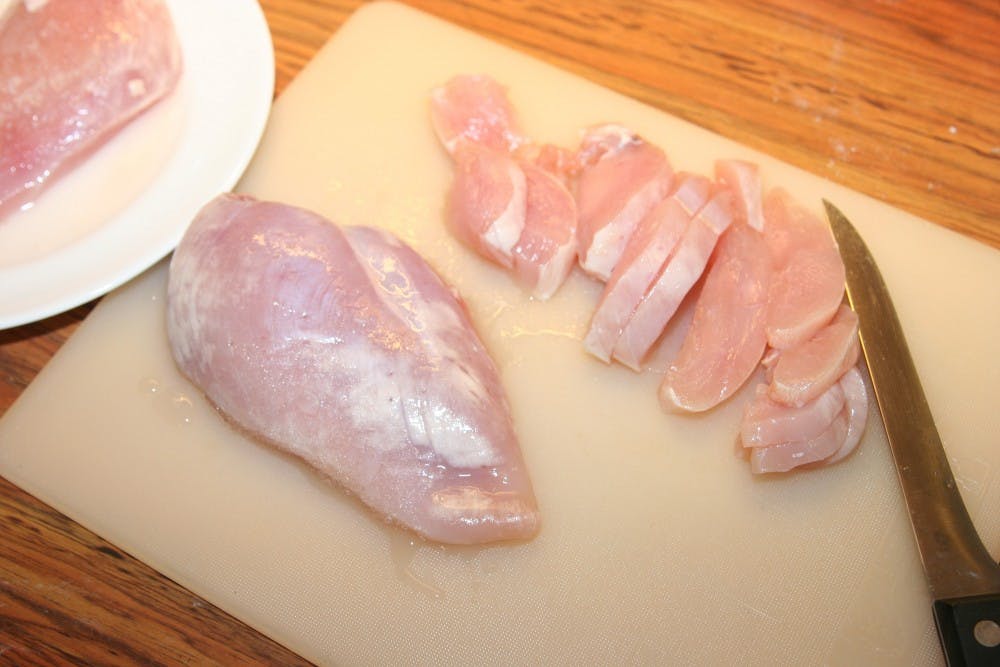Easy Mac and frozen dinners get you by for a few months, but before long, you’re probably going to want something a little tastier and more substantial.
Maybe it’s in a college dorm, an apartment, a house – but cooking is bound to be a necessity, and knowing how to cook chicken is a must.
Cooking chicken might seem like a difficult task, but following these steps will surely keep you — and your chicken — looking good.
Getting Started
Things you'll need
- Chicken breast
- Paper towel
- Roasting pan
- Grill (if you choose)
- Skillet
- Seasoning
- Marinade
1. Defrost the chicken if it was bought frozen.
Place the frozen chicken in the refrigerator the day before you plan to cook it. This is the safest and easiest way to go about defrosting it. If the chicken is still frozen when you want to cook it, use the defrost setting on the microwave to finish the process.
2. Rinse the chicken.
You’ll want to get rid of all the package liquids the chicken has been sitting in, especially if it was bought fresh. To do so, hold the chicken under cool running water.
3. Pat the chicken dry.
Use clean paper towels to soak up any water that remains on the chicken. Discard the paper towels and clean up any chicken juices promptly - raw chicken can carry bacteria, including salmonella, and it’s important to be vigilant about preventing the spread of any bacteria, especially in the kitchen.
4. Marinate or season your chicken.
While this step can vary for each individual, this is a matter of personal taste and you can follow a recipe or make your own unique, homemade recipe. If you think a good tasting chicken is important, this step is necessary.
To marinate the chicken, allow the poultry to sit in a liquid. You can use salad dressing, oil and vinegar, soy sauce or juice of your choosing.
Season the chicken with herbs and spices. Most people use salt and pepper at the least, but you can also use garlic, onion, rosemary, sage, chili powder or whatever you like.
Selecting a Cooking Method
1. Roast the chicken breast in the oven.
Place the chicken breast in a roasting pan or a shallow baking dish. Cook it uncovered at 400 degrees Fahrenheit (204 degrees Celsius) for 20 to 30 minutes.
2. Cook the chicken breast on the grill.
Place the chicken directly on the grill rack, keeping it close to the coals or gas heat. Flip the piece(s) over only once during grilling. It should finish cooking on a hot grill in 15 minutes.
3. Sauté the chicken in a hot skillet or pan on the stove.
If you’re cooking chicken breasts, they can be left whole or sliced up into pieces that will cook more quickly.
Melt butter or heat oil in the pan before you add the chicken. You can also use a non-stick spray.
Let the chicken cook on medium-high heat for about 10 minutes on each side, if keeping the breasts whole. If cutting up the chicken, sauté for up to 10 minutes, stirring the pieces frequently in the pan.
4. Poach the chicken breast in water.
Put the whole chicken breasts in a large skillet and add enough water to cover the whole piece of chicken. Bring the water to a boil and reduce the heat.
Cover the skillet and allow the chicken to cook for about 10 to 12 minutes.
Finished.
Cook your chicken thoroughly to avoid illness or salmonella poisoning. The inside of your chicken breast should be 170 degrees Fahrenheit (77 degrees Celsius) to ensure it has been cooked properly. When you think the chicken has been thoroughly cooked, take the proper steps to ensure the poultry isn’t red and that it’s actually done.
Here are three ways to know when your chicken is ready to serve.
1. Thermometer
The easiest way to know when the chicken is done is to insert an instant-read thermometer into the meat. If the thermometer reads between 165 F and 170 F, it’s done. If the temperature is lower, it needs more time to cook. If the temperature is much higher, it’s probably overcooked. But don’t panic —just use the pan juices to help moisten any dry meat.
2. The juices run clear or nearly clear.
If you don’t have a thermometer, slice through the skin of the chicken and take a look at at the juices it’s cooking in. If the juices are clear, the chicken is likely done. If they’re just slightly pink, try the next test.
3. The meat is firm.
When the chicken is cooked, the meat should feel firm, not loose or rubbery. It also shouldn’t be tight (a sign of overcooking). When you’re examining the juice, also check the meat. If it looks like it’s under-cooked, cook the chicken a little longer.
Info gathered from WikiHow, ourbites.com and foodandwine.com





